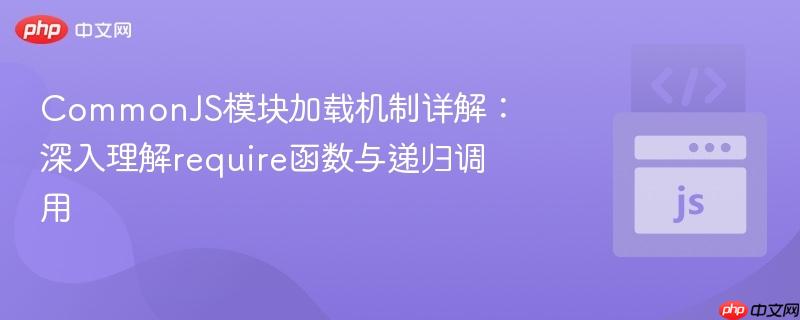
本文旨在深入解析CommonJS模块加载机制,特别是require函数的工作原理。通过模拟require函数的实现,我们详细探讨了模块的缓存机制、wrapper函数的构建与执行,以及require函数如何通过递归调用来处理模块间的依赖关系。理解这些机制对于编写可维护、可扩展的Node.js应用程序至关重要。
CommonJS是一种模块化规范,广泛应用于Node.js环境中。其核心在于require函数,用于加载和使用其他模块。理解require的运作方式是掌握Node.js模块化编程的关键。
以下代码模拟了require函数的基本实现,展示了其核心逻辑:
require.cache = Object.create(null);
function require(name) {
if (!(name in require.cache)) {
let code = readFile(name); // 假设readFile函数负责读取文件内容
let module = { exports: {} };
require.cache[name] = module;
let wrapper = Function("require, exports, module", code);
wrapper(require, module.exports, module);
}
return require.cache[name].exports;
}这段代码的核心在于:
require函数的一个重要特性是支持递归调用。这意味着在一个模块中,可以通过require加载其他模块,而被加载的模块又可以继续加载其他模块,从而形成模块之间的依赖关系。
为了更好地理解递归调用,我们考虑以下示例:
square.js:
// square.js
const square = function (n) {
return n * n;
}
module.exports = square;squareAll.js:
// squareAll.js
const square = require('./square');
const squareAll = function (ns) {
return ns.map(n => square(n));
}
module.exports = squareAll;index.js:
// index.js
const squareAll = require('./squareAll');
console.log(squareAll([1, 2, 3, 4, 5]));当执行index.js时,首先会调用require('./squareAll')。在require函数内部,会读取squareAll.js的代码,并创建一个包装函数:
const wrapper = function (require, exports, module) {
const square = require('./square');
const squareAll = function (ns) {
return ns.map(n => square(n));
}
module.exports = squareAll;
}在执行这个包装函数时,会遇到const square = require('./square'),这会再次调用require函数,加载square.js模块。这个过程就是递归调用。
当square.js模块加载完成后,会返回square函数,并将其赋值给squareAll.js中的square变量。然后,squareAll.js会定义squareAll函数,并将其赋值给module.exports。最后,require('./squareAll')返回squareAll函数,并将其赋值给index.js中的squareAll变量。
通过理解require函数的工作原理,我们可以更好地组织和管理Node.js应用程序的代码,提高代码的可维护性和可扩展性。CommonJS的模块化机制为构建大型、复杂的应用程序提供了强大的支持。
以上就是CommonJS模块加载机制详解:深入理解require函数与递归调用的详细内容,更多请关注php中文网其它相关文章!

每个人都需要一台速度更快、更稳定的 PC。随着时间的推移,垃圾文件、旧注册表数据和不必要的后台进程会占用资源并降低性能。幸运的是,许多工具可以让 Windows 保持平稳运行。




Copyright 2014-2025 https://www.php.cn/ All Rights Reserved | php.cn | 湘ICP备2023035733号